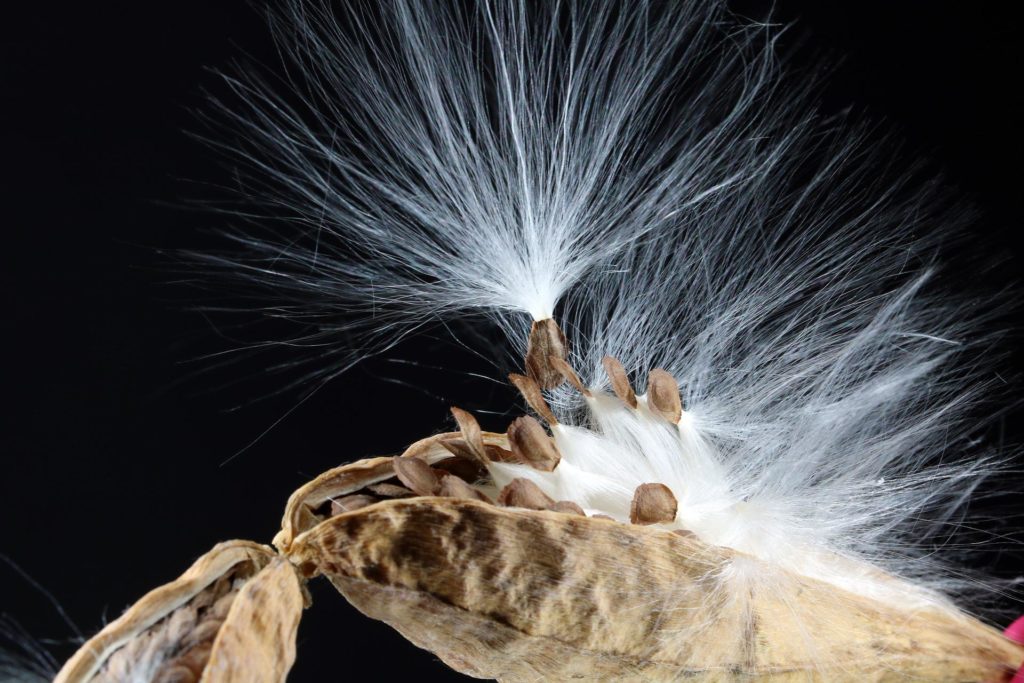How can it be that growing Milkweed is not easy? Isn’t it a weed that grows without any support? Not at all. Some Milkweed Varieties, like Showy Milkweed (Asclepias Speciosa) and Indian Milkweed (Asclepias Eriocarpa), are fragile and grow from seeds only with care. Find out what to do.
COLD-STRATIFICATION
To germinate Milkweed Seeds successfully, you need to copy the normal growth process. In nature, the Milkweed seed pods open up at the end of October and spread their seeds around the mother plant.
The end of October/beginning of November is when you place your Milkweed Seeds in your starter pots. Do not place just one seed in a pot, but be generous and place Showy Milkweed around five seeds and Indian Milkweed about ten seeds.
– The germination ratio is relatively low for Showy Milkweed and even lower for Indian Milkweed –
Make sure not to plant the seeds too deep. 1/2 inch to max 1 inch is enough. Place the pots outside so it can rain on them, but make sure to protect them from too strong rain showers with some mesh – No need to water them additionally, unless the winter is very arid.
The Showy Milkweed Seedlings appear earliest in April, and Indian Milkweed takes a bit longer to appear in May.
If you missed planting your Milkweed Seeds in early winter, you could mimic cold-stratification in your refrigerator. Place the seeds wrapped in a moist paper towel and Ziplock bag in your refrigerator for four weeks. After this time, plant the seeds in pots as described above.
WARM-WATER TECHNIQUE
When you missed altogether to prepare the Milkweed seeds for germination and Spring is coming, you can use the Warm-Water Technique. With this method, only the most vital seeds will germinate, which can be quite an advantage for the future growth process of your Milkweed plants.
Place the seeds in warm water (between 78 and 80 degrees). Use a plastic container or cup. Change the water twice per day to keep the temperature constant. If you have a heating pad to keep the water warm, use it to keep the temperature consistent.
Within two weeks, the most vital seeds will germinate. Plant the germinated seeds with the roots (white part) facing down at a maximum depth of 1 inch.
SEEDLINGS CARE
Showy and Indian Milkweed Seeds have a low ratio of becoming seedlings. So do not be discouraged if only some seeds develop into seedlings. It is a number game, like in nature.
After planting the seeds in your starter pots, ensure that the earth always stays moist. It is better to overwater than let the seeds be in the dry soil. Although too much water is not good, especially for Indian Milkweed.
Place the pots in full sun.
Do not replant the seedlings too soon. It is better to transfer them first into a larger, deep pot and only towards the end of their life cycle (September) into your garden. Also, ensure to take out all the weeds around your Milkweed plants, so there is little competition for nutrients.
Remember, Milkweed is perennial. It will go dormant in late Fall. The leaves will turn yellow and drop off before the entire plant disappears. The Milkweed plant is not dead but conserves all the energy in. the root system from where the new shoots come in Spring.
Happy Gardening!

